Samsung Galaxy Tab 10.1 Review: The Sleekest Honeycomb Tablet
by Anand Lal Shimpi on June 13, 2011 5:07 AM EST- Posted in
- Tablets
- Samsung
- Tegra 2
- Galaxy tab 10.1
- Android 3.1
- Mobile
- NVIDIA
A Beautiful Display
Other than form factor, the 10.1's display is the only other major advantage Samsung holds over ASUS. While the Eee Pad's display is quantifiably similar to Apple's iPad 2, it does fall victim to an incredible amount of glare. There's a sizable gap between the LCD panel and the outermost glass, which results in more glare than most other tablets we've reviewed this generation. The 10.1 however doesn't suffer this fate and as a result is more directly comparable to the iPad 2.
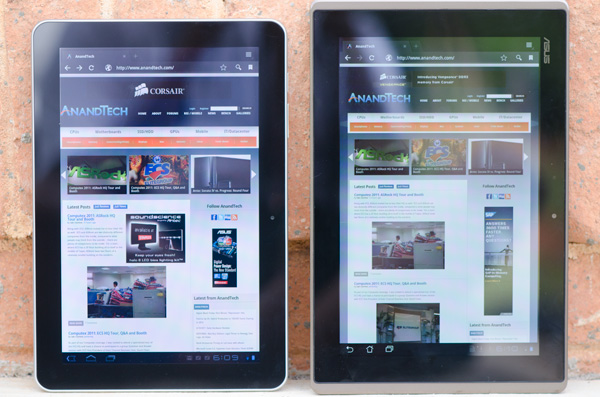
Samsung Galaxy Tab 10.1 (left) vs. ASUS Eee Pad Transformer (right)

Samsung Galaxy Tab 10.1 (left) vs. Apple iPad 2 (right)
While both ASUS and Apple use an IPS panel in their tablets, Samsung uses its own technology called Super PLS (plane line switching). Brian Klug, our resident smartphone and display guru did some digging and it turns out that Super PLS is Samsung's own take on IPS that maintains viewing angle while boosting throughput (brightness). The Samsung supplied photo below shows a comparison of the tradeoff you make with S-IPS and I-IPS, as well as both of those compared to Super PLS:
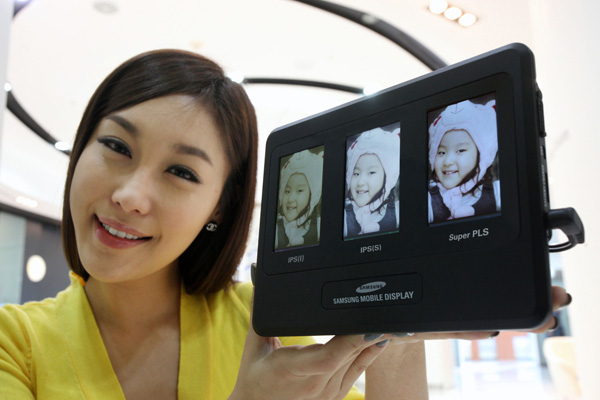
Traditionally you'd have to trade off viewing angle for brightness or vice versa even within the IPS family. Super PLS lets you have your cake and eat it too, giving you the same side viewing angles as S-IPS but with the light throughput of I-IPS.
Perhaps due to the use of Super PLS, Samsung actually managed to outfit the Galaxy Tab 10.1 with a brighter panel than what we saw with the iPad 2. Black levels aren't quite as good but peak brightness is measurably better at nearly 500 nits. While the display isn't what I'd consider bright enough to use in direct sunlight, it is more versatile than the iPad 2's as a result of its brightness.

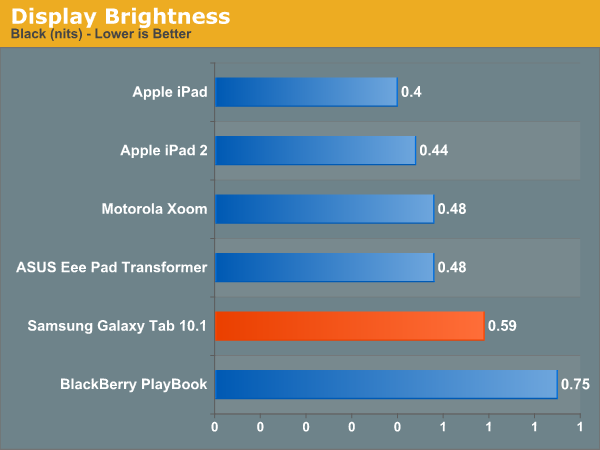
The higher black levels balance out the brighter panel and deliver a contrast ratio comparable to that of the iPad 2:
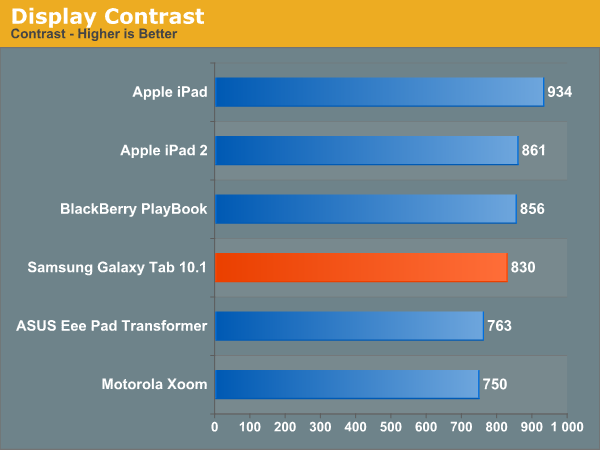
I should mention that the quality of the panel on the retail 10.1 sample is significantly better than what I saw with Samsung's Galaxy Tab 10.1 Limited Edition at Google IO. The sample from IO had noticeably worse black levels, lower peak brightness and as a result lower overall contrast. On top of all of that, the LE suffered light bleed from one of its corners - a problem I haven't seen on the retail 10.1. With only two Galaxy Tabs to compare this is either an indication of wildly varying quality control, or more likely that Samsung simply repackaged its early samples as LEs and saved the mass production hardware for paying customers a month after Google IO.
As you can see in the shot above the Samsung panel has a considerably cooler white point than the Eee Pad Transformer. A quick measure with our colorimeter shows a white point of 8762 (vs 7805K for the Eee Pad). It does make Samsung's default wallpaper look very pretty. If you're wondering, the iPad 2's panel is calibrated to a 6801K white point - at least with our 16GB CDMA sample here.


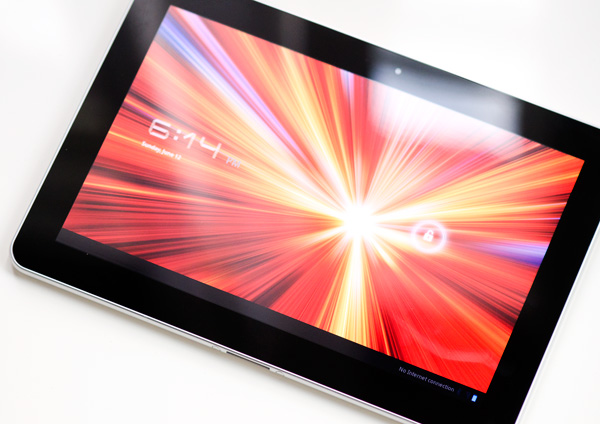
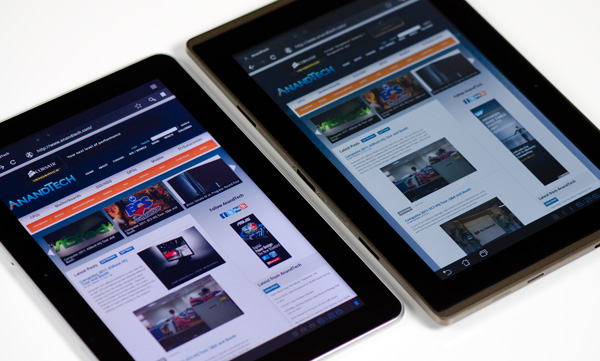








108 Comments
View All Comments
darkhawk1980 - Monday, June 13, 2011 - link
One thing that might be of note to those buying, might be the fact that the secure software key (SSK) for the Asus Transformer has in fact been found. This means that it is now possible to completely unlock the device to do whatever you'd like with it (ie possibly install Ubuntu Linux?). This is something that I'd be surprised if it happened with the Samsung Tab 10.1. While for most people it probably doesn't make a huge difference, but in another month the ability to have both Honeycomb and Ubuntu on the device could be a very compelling argument.Personally, given how much Samsung locks down their devices, I would never buy into their tablets. I still believe the Asus provides a much better overall experience. While it isn't the lightest, nor is it the most thin, it provides the best experience and flexibility. And to be perfectly honest, the price is pretty damn good as well. Having a rooted Asus and being able to overclock it a bit (1.6 GHz and really stable) makes a pretty decent difference in performance.
BTW, I've always wondered, how much of a difference does the resolution difference between the IPad 2 and all other Honeycomb tablets make a difference in the graphical benchmarking tools? I would imagine it does make a decent difference, all things given.
My experience with tablets thus far (have spent a few hours looking at the Acer Iconia and Samsung/Xoom at Best Buy, and bought a Transformer) is that I really do enjoy having it. I like being able to pick it up and browse the web while watching TV during commercials or boring parts of a show. I love reading books and comic books on it. And to be perfectly honest, since I got Plants vs. Zombies the other day for free from Amazon, I use it way too much. More than my wife I think.....
adt6247 - Monday, June 13, 2011 - link
Samsung locking down devices? You on crack? All of the Galaxy S devices shipped with unlocked boot loaders. Samsung also just sent a few Galaxy S II phones to the CyanogenMod team that brought CM7 to the various GSM Galaxy S variants. I rooted my Captivate within an hour of purchase, and I got it on launch day. How much less locked down do you want?My biggest complaint with Samsung was TouchWiz, and that simply isn't an issue here.
ph00ny - Monday, June 13, 2011 - link
That's what i was about to say. Only company active leaving the bootloader unlockedmongo lloyd - Monday, June 13, 2011 - link
Reports have said that Samsung will deliver its TouchWiz UI enhancements in a later update.You can see a very recent video of how it looks on the 8.9 here: http://www.youtube.com/watch?v=yj7M1WTiwGo
StormyParis - Monday, June 13, 2011 - link
to see the insta-obsolescence of those things. Each month brings a new tablet that's da schinitz... for a month. And now Tegra 3 will arrive within a couple of months, and the OEMs that kind messed up first time around (Motorola, a lot; Asus, a bit) will have a second shot at leading the field... Any tablet will be upstaged within 6 tot 12 months anyway, which really is a pain because the new ones will be significantly better (and the current ones are barely "good enough", and those things are a lot more expensive than subsidized phones.I started out waiting for any Android tablet. The first ones, especially the Xoom, where pretty awful, so that morphed into waiting for the eeePad... which is OK, but not as good as the Galaxy. Now I'm thinking 10" is too big. It won't fit into my man-purse and is a bit unwieldy... but the 7-8" alternatives are pretty niche and/or lackluster.
So, in the end, I'm thinking I'll get a cheap Chinese knock-off, test out the format (for web surfing, ebooks, comics, and some videos), and wait 12-24 months for the dust to settle. I've found 8 inchers around 100 USD with 1280x800 and 1024x600 screens (Ainol Novo 8, Zenithink E98)
JasonInofuentes - Monday, June 13, 2011 - link
That's not a terrible plan but try not to be too disheartened. This is simply the expected process of performance increasing with technology advancements played forward really fast. Ten years ago when deciding what computer to buy you would have asked yourself a few questions that had to do with features; at the time they would have involved playing the latest games, fast internet access, expandability and sufficient storage. So, a Radeon 9700, an ethernet NIC, a decent case, a 40 GB drive and a Pentium IV and you were all set. A few years ago you would have added HD video playback, WiFI and turned all the other dials up a few notches. And that's basically where we are today. Ten years ago to meet the demands of most users you needed a pretty high end system, anything less and the compromises were pretty high. Today, a decent video card (nothing integrated, yet), a cheap mobo with all the bells and whistles integrated, a cheap 2TB drive, and Intels cheapest Pentium will probably hit all your feature requests and still fit in a case smaller than the box my 9700 came in.In tablet talk, we are, thankfully, a bit beyond the Pentium IV era, but we're not quite at Penryn, and still a few years off from Nehalem. You can play games, you can watch HD video and you can do all the other things you want to do, you just can't do it as smoothly as you might want, and certainly not so smoothly as you could on your netbook. But we're in the post-PC era, so the days will come.
If I were you, still expecting to wait as much as two years before really committing to the cause, I'd hold off on that Chinese grey market special, pick-up a used Nook Color and throw CM7 on it. It's not Honeycomb but it's not bad either. And when you decide the market is ready for you to throw some real money on a tablet it'll be like booting up a Sandy Bridge powered MacBook Pro after years of using a Powerbook G4. Let us know how it goes!
StormyParis - Monday, June 13, 2011 - link
I'd go for the nook color in a blink if I could get it. I'm in France though, and don't know anyone in the US. Even my brother in Canada can't et it, as far as I can tell.jrs77 - Monday, June 13, 2011 - link
First of all, nice review there Anand.The Galaxy Tab 10.1 looks really good actually and with the bigger resolution then the iPad2 it's more to my liking. However, Android still doesn't feel as good as iOS and that's the real downside of the iPad-competition currently. With a pricetag of the iPad2 I'd take the better OS and go with Apple still, as I don't mind about the iTunes-thingy actually for a device that's primarily ment to browse the web or watch movies while travelling from/to work every day.
I'd like to see a tablet with a fully suported USB-port, that let's me use a internet-stick or external storage, with a pricetag of a netbook ($400). That would really be a step forward actually.
tayb - Monday, June 13, 2011 - link
Still sucks. I'm sorry, but it does. It's half baked and crashes more than a Microsoft Windows beta. It's not a finished product and I'm starting to understand how Google seems to make such rapid improvements to their OS. It's because they release the beta as the full version and then fix all of the massive holes and bugs with new OS releases.I still don't see a tablet offering from any company that I would actually be interested in. $499 for this is not a great deal unless you compare it to the iPad. Hey, the iPad is overpriced. I can walk into any electronics store and get a powerful notebook for $499.
ph00ny - Monday, June 13, 2011 - link
Have you tried 3.1 honeycomb tablets over 3.0? It looks like they're progressing very nicely